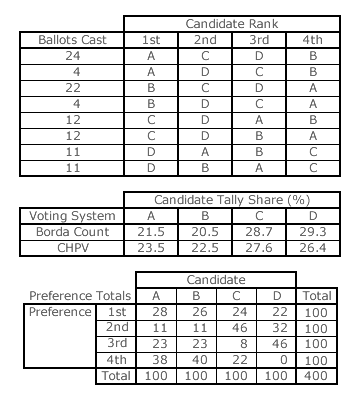Borda count
In a Borda count of the voter preferences are determined based on a ranking. First place gets the most points, second place one point less than the first, third place one point less than the second, the fourth place one point less than the third, etc.
There are two different methods to determine the score for the first place: the simpler method returns the initial placement, one point less than there are total of candidates so that a completely filled Ranking the Final are 0 points. The voter has the opportunity to enter by waiving further honest information after the initial placement of his favorites better opportunities. The modified version, however, are the winners as many points as the voter has placed candidates. If only two marks, there are only 2 points for the first and second placed 1 point. Are marked 8, gets the first eight points of the second 7
Borda has a weak point: the method is not immune against clone attacks. This means that an ideology can increase their chances of success considerably by increasing the number of their candidates. Borda is however used in competitions such as the Euro Vision Song Contest (but partially in a modified form, for example, gets 10 candidates of the first 12 points and the second 10 points instead of 10 and 9 respectively).
The choice Borda violates the independence of irrelevant alternatives. This paradox of the ranking rating by Borda results, for example, that the exclusion of a candidate after the election changes the original ranking of the remaining candidates. A contrived example with four candidates and seven jurors:
Here candidate c is the winner. After exclusion of the candidate d, which has the lowest score, a victory for a yields
This selection method was proposed by Nicolaus Cusanus in De concordantia catholica 1433, but remained unnoticed and is now assigned to the Frenchman Jean Charles Borda. This was among others in conflict Marquis de Condorcet to whose Condorcet method is now used by some organizations for elections.
There are numerous other methods for aggregation of preferences:
- Valuation options
- Election by consent
- Majority voting ( with and without runoff )
- Instant Runoff Voting
- Condorcet method Ranked Pairs
- Schulze method.
The social choice theory (English Social Choice Theory) deals with these procedures and rules.










